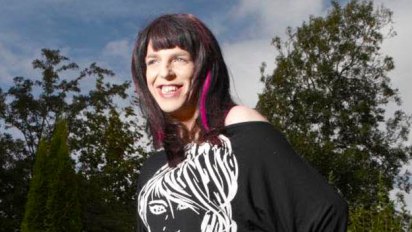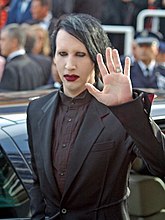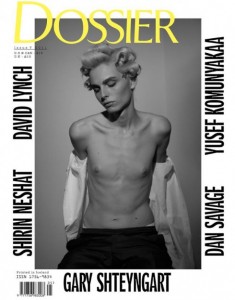I discovered the existence of Andrej Pejic through Quiet Riot Girl (who occasionally comments on Caroline Farrow’s blog and has her own website devoted to gender issues here). The Vortex's videos on masculinity/femininity (H/T Arundel & Brighton Latin Mass Society) prompted some further reflections.
Andrej Pejic (rather improbably pronounced ‘Page’ according to Wikipedia) is a model who has been featured in a number of campaigns including one for push up bras. There’s a picture above. Rather fetching picture too…
But Andrej is a man.
When I first realized this, there is that first initial shock of discovering that you’ve found a man attractive. And of course that’s part of the narrative here. Buttoned up homophobes like myself (and all the 1 billion other Catholics –excepting only the illumined readers of The Tablet) are forced to confront the fluidity of gender and the fluidity of their own desire. Initial shock. Change of view. Change of heart. Dancing and the end of history and biology in one long happy, polymorphously perverse embrace.
Well, let’s pick this apart a little. Pejic –in the photo above- looks like a woman. Now before the queer theorists out there jump around and start asking what a woman looks like and accusing me of essentialism and the rest (a charge to which I’d happily plead guilty), I’d argue that the whole effect of the picture is lost unless a) it looks like a woman and b) it isn’t. Moreover, it uses the ‘signifiers’ of being a woman (dress, hairstyle) to represent a woman.
To see this, contrast the image above with some other androgynous images:
(from the Channel 4 website for the programme My Transsexual Summer)
or
(the musician, Marilyn Manson).
Both these images represent –in a way that Pejic’s one above doesn’t- a blurring of the feminine and the masculine. If Pejic’s image is troubling, it is not troubling in the same way that these two images are troubling: Pejic looks like a woman; the other two images don’t.
Essentially the same point was made by Caroline Farrow in one of her comments on QRG’s posting: ‘…were there any manifest signs of masculinity would he have been selected?’ QRG’s response is that, ‘If you look at a selection of photos of Pejic he doesn’t always look ‘feminine’ he is genuinely versatile with his gender presentation.’
And that’s quite true. If you look at this image, for example (H/T Lela London) it is genuinely androgynous in the way the first image isn’t. And here
he is clearly ‘a dude’ in the left hand photo.
So what does all this tell us? Queer theory would have us believe that it shows gender and sex is constructed and fluid. What’s a Catholic position?
The first image of Pejic shows that images are constructed and can fool us. That’s not surprising. Quite apart from airbrushing and more invasive techniques, there is always the question of culturally constructed items such as dress and hairstyle: I can’t think of any Catholic, even the most traditionalist, who thinks women were born with long hair and dresses. The fact that images exist which can fool us into thinking something is something else is not, in itself, terribly surprising. We can be tricked. Big deal.
But this might be thought to be missing the point. Even if that first image of Pejic isn’t a representation of androgyny, the portfolio of images is. OK. But what does that demonstrate? That a man can look like a woman? Yes. That a man can look a bit like a woman? Yes. That a man can look a bit like someone who isn’t clearly a woman or a man? Yes. All these things are true, but so what? The assumption here is that to look like something is to be something. And that’s clearly false. (‘He looked like a friendly dog until he bit me.’)
Borrowing a Scholastic distinction between actus (actualization) and potentia (potential) (here), being a woman or a man is more than being an image, it is more than just (to borrow the jargon) ‘performativity’ (all examples of actus); it is instead potentia –the possibility and potential for future actualizations. I may be fooled by a current image or even by current actions, but what I am being fooled about is future potential: someone who is not a woman will not always act like (have the actus of) a woman.
The deeper question here is: could the performativity of being a woman go ‘all the way down’? Could someone always have all the actus of a woman without being one? If the circumstances are restricted enough, the answer is clearly yes. If the only actus you are concerned with are fashion images, there are no particular reasons why Pejic or anyone else with the right bone structure and preparation couldn’t go on looking like a woman. (If, say, the effects of aging hardened the jaw line, then you would simply stop taking the images: you would walk off the stage and stop performing.) But if we are not talking about a stage but about the whole of life, then the answer is no. There are two ways of developing this point. First, there is the materialist way. Pejic doesn’t have a woman’s body. Whatever he may look like, the potentia of that body is male. (It will age like a male. It will produce hormones like a male. It will sicken like a male.) Second, there is the metaphysical and theological way. For Balthasar, for example, the natures of man and woman as separate sexes are an imago Trinitatis: the differences go all the way down to the very origin of the world in creation.
In sum, the fact that one image or a collection of images is misleading shows nothing but that a very small subset of actualizations can be misleading about the potential for actualization of that person. It is the potentia of man and woman that dictates whether there is a real difference between the two, not a small selection of actus. And there are good reasons –both on materialistic and metaphysical grounds- for thinking that there are significant differences between men and women, even if those differences are not, on a particular occasion or in a particular image, actualized and revealed.
Misleading images are exactly that. Simply misleading. Simply images. They reveal more about the intention of those constructing them than about the nature of reality.






No comments:
Post a Comment